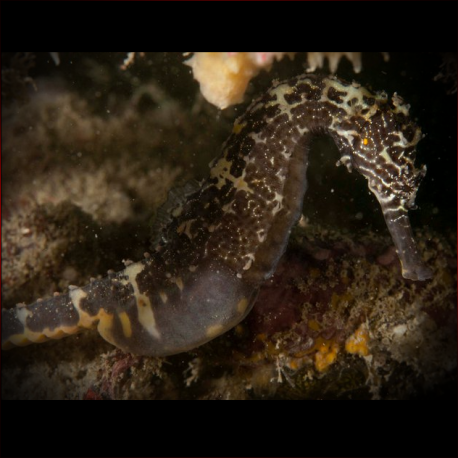More info
Datasheet
| Minimum Tank Size | 113 litres / 29.85 US gallons |
| Maximum Size | 15.7cm / 6.18inches |
| Reef Compatible | Yes |
| Temperament | Peaceful |
| Care Description | Difficult |
| Specific Gravity | 1.020-1.025 |
| Carbonate Hardness | 8-12 |
| pH | 8.1-8.4 |
General Description
The Tiger-Tail Seahorse, scientifically known as Hippocampus comes, is a captivating species featuring a striking yellow and black coloration. Adorned with beautiful markings around the eyes, this seahorse species boasts numerous stripes and blotchy patterns that aid in camouflage.
Aquarium Suitability
The Tiger-Tail Seahorse is best suited for a dedicated species-only tank of at least 30 gallons or more. They thrive in the presence of multiple Gorgonians, which they can cling to with their prehensile tails. In the absence of Gorgonians, plastic plants can serve as suitable substitutes. It is important to avoid housing them with aggressive tankmates such as blennies, gobies, or triggerfish, as they can cause stress to the seahorses.
Care and Hardiness
Considered challenging to care for, Tiger-Tail Seahorses require specific attention to thrive in captivity. They are slow and deliberate feeders, making it crucial to ensure they receive adequate nutrition without competition from faster, aggressive tankmates.
Reef Suitability
The Tiger-Tail Seahorse is deemed reef-compatible, allowing them to coexist peacefully with coral and other reef inhabitants in a well-established reef tank.
Aquarium Setup
For optimal care, provide the seahorses with a dedicated tank containing live rock and suitable decor for perching. It is recommended to feed them frozen vitamin-enriched mysis shrimp at least twice daily for their dietary needs.
Behaviour
These seahorses exhibit a peaceful temperament, preferring a calm and undisturbed environment. They are known to get along well with pipefish, although slight competition for food may arise due to the pipefish's faster feeding habits.
Feeding and Diet
As carnivorous creatures, Tiger-Tail Seahorses thrive on a diet of frozen mysis shrimp. Ensuring they receive sufficient food intake without competition is crucial to their well-being.
Dimorphism and Captive Reproduction
In captivity, Tiger-Tail Seahorses often display dimorphism, with males carrying and birthing the young seahorses after a gestation period. To support successful captive breeding, providing a separate aquarium with appropriate conditions for newborn seahorses is essential.
Habitat and Distribution
These seahorses are found in tropical waters, typically inhabiting areas with plentiful vegetation and suitable substrate for perching. Their natural distribution spans regions conducive to their unique habitat requirements.

